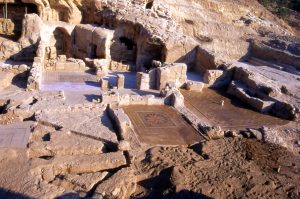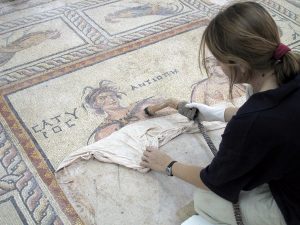Temporary support on clay
The first, urgent operation consisted in verifying the strength of adhesion of the facing that had been applied during lifting. This was the only supporting element for the tesserae and the risk of detachment during treatment was extremely high. In many cases, immediate replacement of the facing was necessary due to the ageing adhesives and deteriorating textiles, which were often broken and lacked mechanical resistance. As often happens, a support that was designed to be temporary had turned into a long-term solution, and had deteriorated as a result of unfavorable environmental conditions. Textiles that had been attacked by mice, weakened by mold and deformed by the weight of the fragments could no longer support millions of tesserae, and with them the history and art of mosaics at Zeugma.
Where substituting the facing was a priority, the tessellatum was positioned on a temporary clay bedding.










